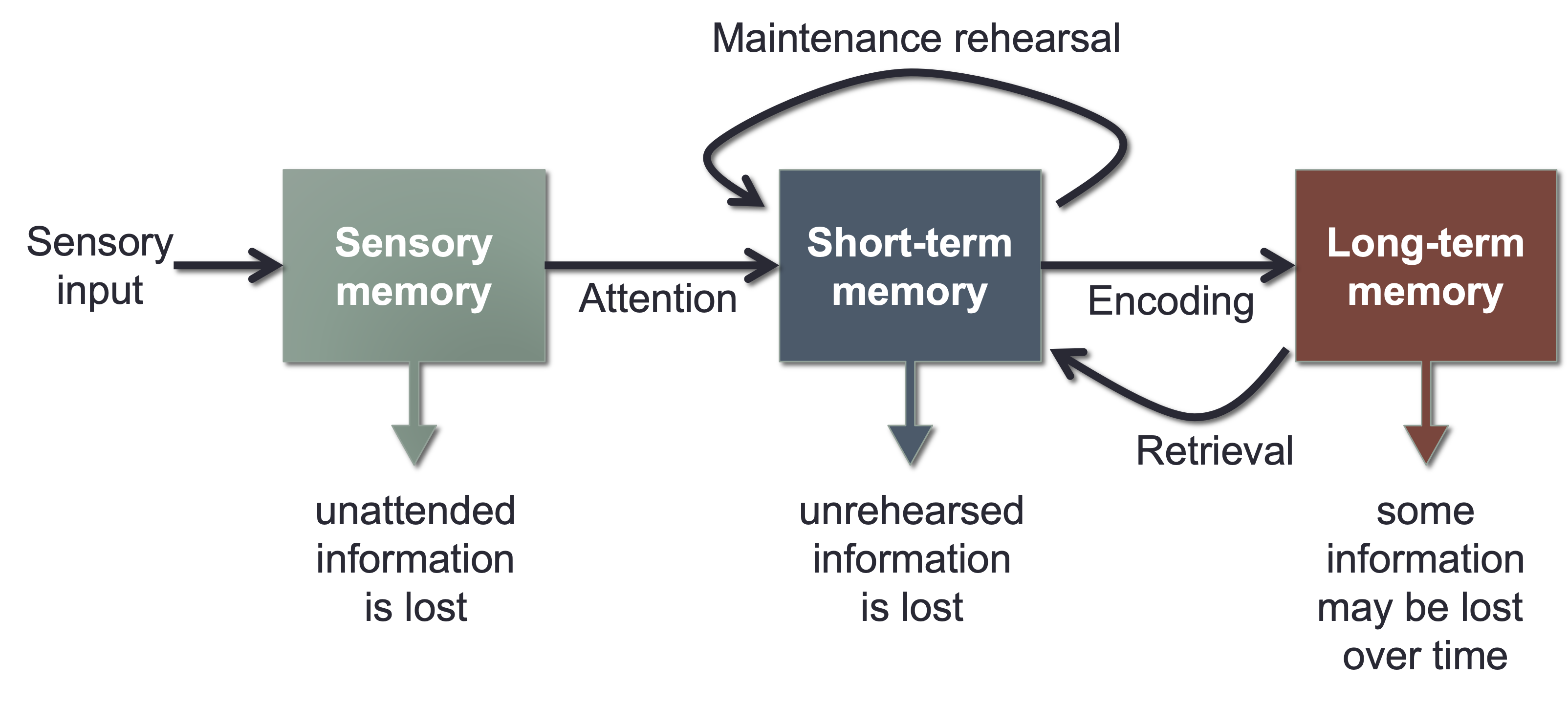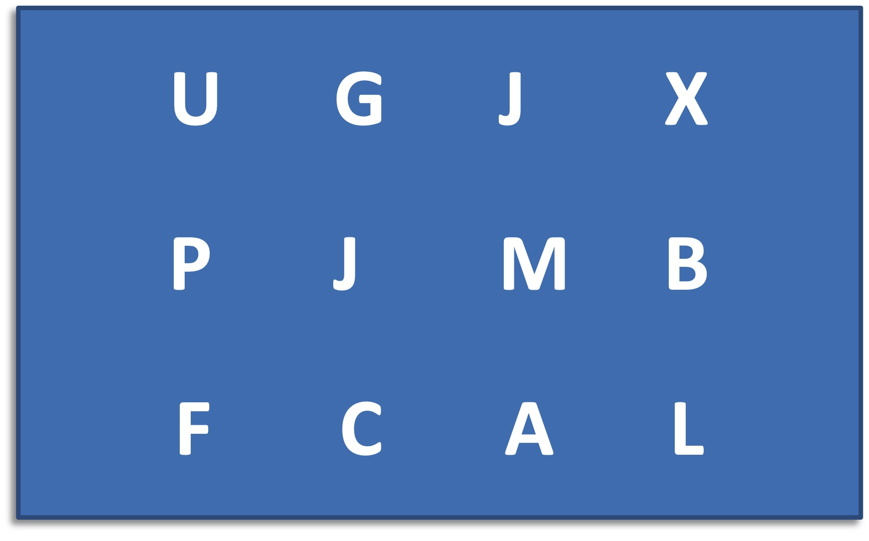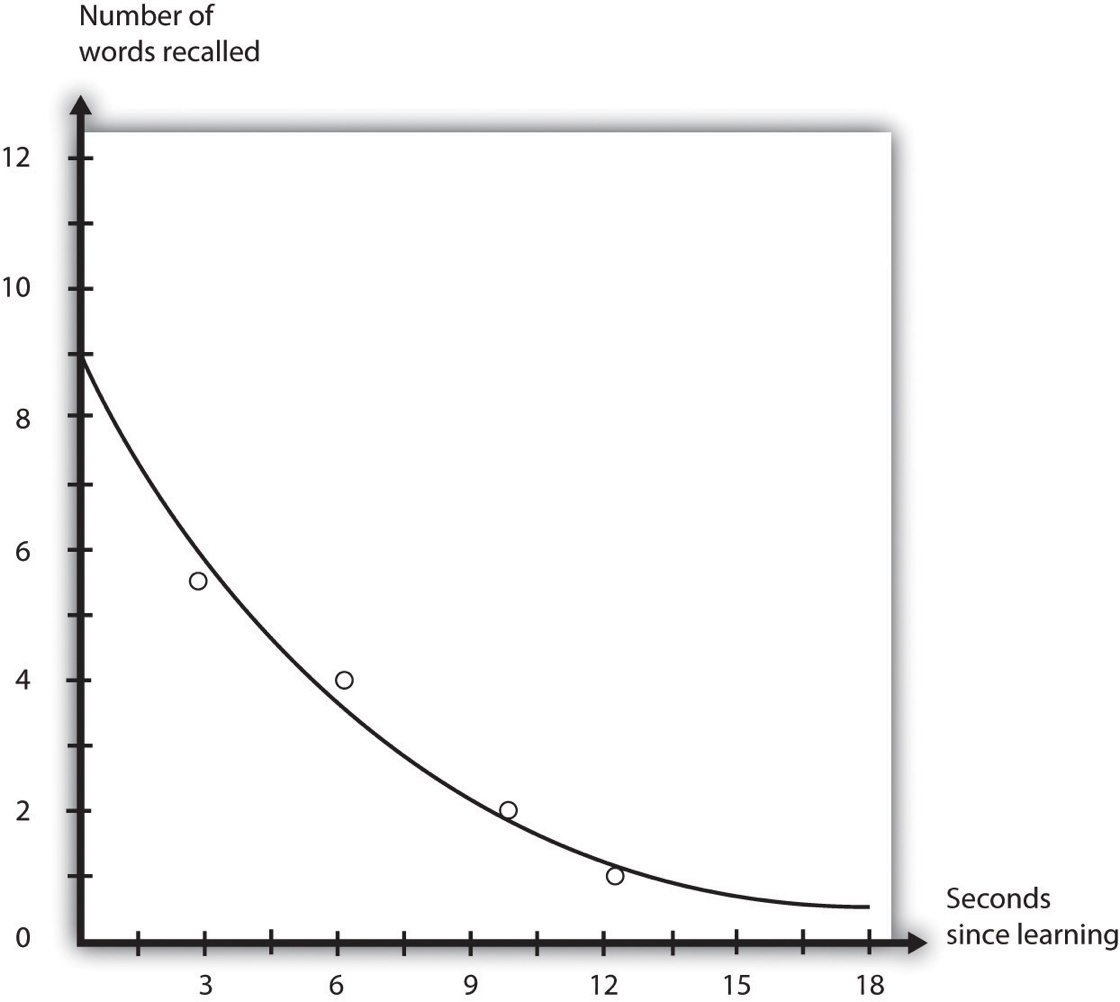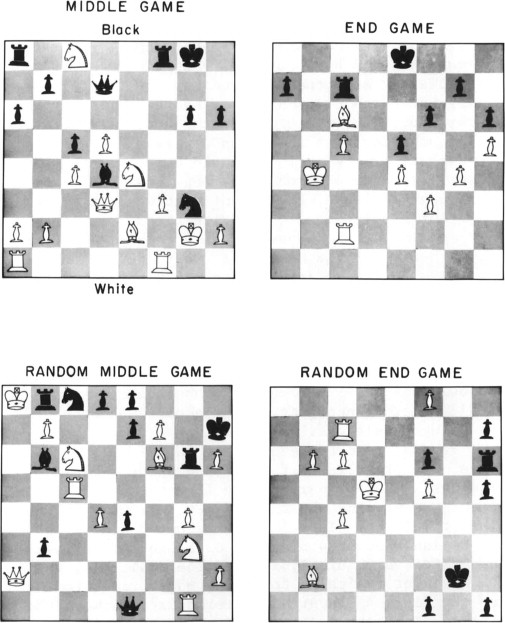Memory
Psychologists conceptualize memory in terms of types, in terms of stages, and in terms of processes. In this section we will cover the three major memory stages: sensory memory, short-term or working memory, and long-term memory (Atkinson & Shiffrin, 1968). Then, in the next section, we will consider the nature of long-term memory, with a particular emphasis on the cognitive techniques we can use to improve our memories. Our discussion there will focus on the three processes that are central to long-term memory: encoding, storage, and retrieval.
Stages of Memory
Adapted from Introduction to Psychology - 1st Canadian Edition by Jennifer Walinga and Charles Stangor.
One way of understanding memory is to think about it in terms of stages that describe the length of time that information remains available to us. According to this approach (see Figure 9.4, “Memory Duration”), information begins in sensory memory, moves to short-term memory or working memory, and eventually moves to long-term memory. But not all information makes it through all three stages; most of it is forgotten. Whether the information moves from shorter-duration memory into longer-duration memory or whether it is lost from memory entirely depends on how the information is attended to and processed.

Sensory Memory
Sensory memory refers to the brief storage of sensory information. Sensory memory is a memory buffer that lasts only very briefly and then, unless it is attended to and passed on for more processing, is forgotten. Sensory memory gives the brain some time to process incoming sensations and allows us to see the world as an unbroken stream of events rather than as individual pieces.
Visual sensory memory is known as iconic memory. Iconic memory was first studied by the psychologist George Sperling (1960). In his research, Sperling showed participants a display of letters in rows, similar to that shown in the figure below. However, the display lasted only about 50 milliseconds (1/20 of a second). Then, Sperling gave his participants a recall test in which they were asked to name all the letters that they could remember. On average, the participants could remember only three or four of the letters that they had seen.

Sperling reasoned that the participants had seen all the letters but could remember them only very briefly, making it impossible for them to report them all. To test this idea, in his next experiment, he first showed the same letters, but then after the display had been removed, he signaled to the participants to report only the letters from either the first, second, or third row. In this condition, the participants now reported almost all the letters in that row. This finding confirmed Sperling’s hunch: participants had access to all of the letters in their iconic memories, and if the task was short enough, they were able to report on the part of the display he asked them to. The “short enough” is the length of iconic memory, which turns out to be only a fraction of a second.
Auditory sensory memory is known as echoic memory. In contrast to iconic memories, which decay very rapidly, echoic memories can last as long as four seconds (Cowan, Lichty, & Grove, 1990). This is convenient as it allows you — among other things — to take notes on your psychology professor’s most recent statement even after he or she has finished saying it.
In some people iconic memory seems to last longer, a phenomenon known as eidetic imagery (or photographic memory) in which people can report details of an image over long periods of time. These people, who often suffer from conditions such as autism, claim that they can “see” an image long after it has been presented, and can often report accurately on that image. There is also some evidence for eidetic memories in hearing; some people report that their echoic memories persist for unusually long periods of time. The composer Wolfgang Amadeus Mozart may have possessed eidetic memory for music, because even when he was very young and had not yet had a great deal of musical training, he could listen to long compositions and then play them back almost perfectly (Solomon, 1995).
Short-Term Memory
Most of the information that gets into sensory memory is forgotten, but information that we turn our attention to, with the goal of remembering it, may pass into short-term memory. In short-term memory (STM), small amounts of information can be temporarily kept for more than a few seconds but usually for less than one minute (Baddeley, Vallar, & Shallice, 1990). Information in short-term memory is not stored permanently but rather becomes available for us to process. The processes that we use to make sense of, modify, interpret, and store information in STM are known as working memory.
Although it is called memory, working memory is not just a store of memory like STM but is also a set of memory procedures or operations. Imagine, for instance, that you are asked to participate in a task such as this one, which is a measure of working memory (Unsworth & Engle, 2007). Each of the following questions appears individually on a computer screen and then disappears after you answer the question:
| Is 10 × 2 - 5 = 15? (Answer YES OR NO) Then remember “S” |
| Is 12 ÷ 6 - 2 = 1? (Answer YES OR NO) Then remember “R” |
| Is 10 × 2 = 5? (Answer YES OR NO) Then remember “P” |
| Is 8 ÷ 2 - 1 = 1? (Answer YES OR NO) Then remember “T” |
| Is 6 × 2 - 1 = 8? (Answer YES OR NO) Then remember “U” |
| Is 2 × 3 - 3 = 0? (Answer YES OR NO) Then remember “Q” |
To successfully accomplish the task, you have to answer each of the math problems correctly and at the same time remember the letter that follows the task. Then, after the six questions, you must list the letters that appeared in each of the trials in the correct order (in this case S, R, P, T, U, Q).
To accomplish this difficult task you need to use a variety of skills. You clearly need a temporary memory store (something like STM), as you must keep the letters in storage until you are asked to list them. But you also need a way to make the best use of your available attention and processing. For instance, you might decide to use a strategy of repeat the letters twice, then quickly solve the next problem, and then repeat the letters twice again including the new one. Keeping this strategy (or others like it) going is the role of working memory’s central executive — the part of working memory that directs attention and processing. The central executive will make use of whatever strategies seem to be best for the given task. For instance, the central executive will direct the rehearsal process, and at the same time direct the visual cortex to form an image of the list of letters in memory. You can see that although STM is involved, the processes that we use to operate on the material in memory are also critical.
Short-term memory is limited in both the length and the amount of information it can hold. Peterson and Peterson (1959) found that when people were asked to remember a list of three-letter strings and then were immediately asked to perform a distracting task (counting backward by threes), the material was quickly forgotten (see figure below), such that by 18 seconds it was virtually gone.

One way to prevent the decay of information from short-term memory is to rehearse it. Maintenance rehearsal is the process of repeating information mentally or out loud with the goal of keeping it in memory. We engage in maintenance rehearsal to keep something that we want to remember (e.g., a person’s name, email address, or phone number) in mind long enough to write it down, use it, or potentially transfer it to long-term memory.
If we continue to rehearse information, it will stay in STM until we stop rehearsing it, but there is also a capacity limit to STM. Try reading each of the following rows of numbers, one row at a time, at a rate of about one number each second. Then when you have finished each row, close your eyes and write down as many of the numbers as you can remember.
019
3586
10295
861059
1029384
75674834
657874104
6550423897
If you are like the average person, you will have found that on this test of working memory, known as a digit span test, you did pretty well up to about the fourth line, and then you started having trouble. You probably missed some of the numbers in the last three rows, and did pretty poorly on the last one.
The digit span of most adults is between five and nine digits, with an average of about seven. The cognitive psychologist George Miller (1956) referred to “seven plus or minus two” pieces of information as the “magic number” in short-term memory. But if we can only hold a maximum of about nine digits in short-term memory, then how can we remember larger amounts of information than this? For instance, how can we ever remember a 10-digit phone number long enough to dial it?
One way we are able to expand our ability to remember things in STM is by using a memory technique called chunking. Chunking is the process of organizing information into smaller groupings (chunks), thereby increasing the number of items that can be held in STM. For instance, try to remember this string of 12 letters:
XOFCBANNCVTM
You probably won’t do that well because the number of letters is more than the magic number of seven.
Now try again with this one:
CBSNBCABCHBO
Would it help you if I pointed out that the material in this string could be chunked into four sets of three letters each? I think it would, because then rather than remembering 12 letters, you would only have to remember the names of four television stations. In this case, chunking changes the number of items you have to remember from 12 to only four.

Experts rely on chunking to help them process complex information. Simon and Chase (1973) showed chess masters and chess novices various positions of pieces on a chessboard for a few seconds each. The experts did a lot better than the novices in remembering the positions because they were able to see the “big picture.” They didn’t have to remember the position of each of the pieces individually, but chunked the pieces into several larger layouts. But when the researchers showed both groups random chess positions — positions that would be very unlikely to occur in real games — both groups did equally poorly, because in this situation the experts lost their ability to organize the layouts (see figure below). The same occurs for basketball: basketball players recall actual basketball positions much better than do nonplayers, but only when the positions make sense in terms of what is happening on the court, or what is likely to happen in the near future, and thus can be chunked into bigger units (Didierjean & Marmèche, 2005).
If information makes it past short term-memory it may enter long-term memory (LTM), memory storage that can hold information for days, months, and years. The capacity of long-term memory is large, and there is no known limit to what we can remember (Wang, Liu, & Wang, 2003). Although we may forget at least some information after we learn it, other things will stay with us forever. In the next section we will discuss the principles of long-term memory.
Key Takeaways
- Memory refers to the ability to store and retrieve information over time.
- For some things our memory is very good, but our active cognitive processing of information ensures that memory is never an exact replica of what we have experienced.
- Information processing begins in sensory memory, moves to short-term memory, and eventually moves to long-term memory.
- Maintenance rehearsal and chunking are used to keep information in short-term memory.
- The capacity of long-term memory is large, and there is no known limit to what we can remember.
Exercises and Critical Thinking
- List some situations in which sensory memory is useful for you. What do you think your experience of the stimuli would be like if you had no sensory memory?
- Describe a situation in which you need to use working memory to perform a task or solve a problem. How do your working memory skills help you?
References
- Atkinson, R. C., & Shiffrin, R. M. (1968). Human memory: A proposed system and its control processes. In K. Spence (Ed.), The psychology of learning and motivation (Vol. 2). Oxford, England: Academic Press.
- Baddeley, A. D., Vallar, G., & Shallice, T. (1990). The development of the concept of working memory: Implications and contributions of neuropsychology. In G. Vallar & T. Shallice (Eds.), Neuropsychological impairments of short-term memory (pp. 54–73). New York, NY: Cambridge University Press.
- Bargh, J. A., Chen, M., & Burrows, L. (1996). Automaticity of social behavior: Direct effects of trait construct and stereotype activation on action. Journal of Personality & Social Psychology, 71, 230–244.
- Bridgeman, B., & Morgan, R. (1996). Success in college for students with discrepancies between performance on multiple-choice and essay tests. Journal of Educational Psychology, 88(2), 333–340.
- Cowan, N., Lichty, W., & Grove, T. R. (1990). Properties of memory for unattended spoken syllables. Journal of Experimental Psychology: Learning, Memory, and Cognition, 16(2), 258–268.
- Didierjean, A., & Marmèche, E. (2005). Anticipatory representation of visual basketball scenes by novice and expert players. Visual Cognition, 12(2), 265–283.
- Haist, F., Shimamura, A. P., & Squire, L. R. (1992). On the relationship between recall and recognition memory. Journal of Experimental Psychology: Learning, Memory, and Cognition, 18(4), 691–702.
- Miller, G. A. (1956). The magical number seven, plus or minus two: Some limits on our capacity for processing information. Psychological Review, 63(2), 81–97.
- Nelson, T. O. (1985). Ebbinghaus’s contribution to the measurement of retention: Savings during relearning. Journal of Experimental Psychology: Learning, Memory, and Cognition, 11(3), 472–478.
- Peterson, L., & Peterson, M. J. (1959). Short-term retention of individual verbal items. Journal of Experimental Psychology, 58(3), 193–198.
- Simon, H. A., & Chase, W. G. (1973). Skill in chess. American Scientist, 61(4), 394–403.
- Solomon, M. (1995). Mozart: A life. New York, NY: Harper Perennial.
- Sperling, G. (1960). The information available in brief visual presentation. Psychological Monographs, 74(11), 1–29.
- Unsworth, N., & Engle, R. W. (2007). On the division of short-term and working memory: An examination of simple and complex span and their relation to higher order abilities. Psychological Bulletin, 133(6), 1038–1066.
- Wang, Y., Liu, D., & Wang, Y. (2003). Discovering the capacity of human memory. Brain & Mind, 4(2), 189–198.
Image Attributions
- Bob Slevc, CC-BY-SA, adapted from Atkinson & Shiffrin (1968)
- Walinga & Stangor (2014), CC-BY-NC-SA, adapted from Peterson & Peterson (1959).
- Giovannihbartlett, CC BY-SA 4.0, via Wikimedia Commons
Adapted from
- Introduction to Psychology - 1st Canadian Edition by Jennifer Walinga and Charles Stangor.

This work is licensed under a Creative Commons Attribution-NonCommercial-ShareAlike 4.0 International License.